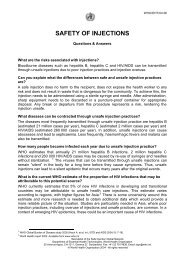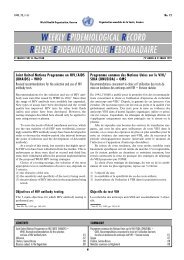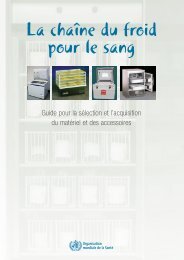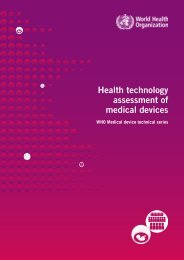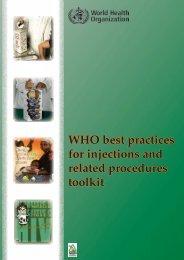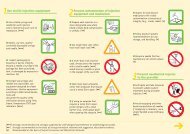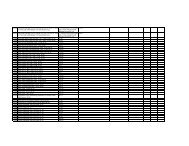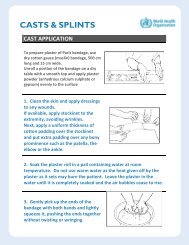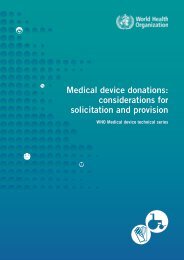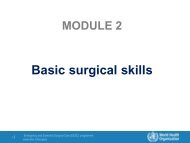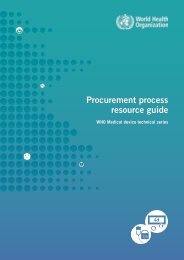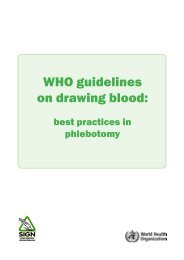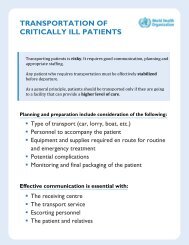Airway Management
Airway Management
Airway Management
Create successful ePaper yourself
Turn your PDF publications into a flip-book with our unique Google optimized e-Paper software.
AIRWAY MANAGEMENT<br />
First priority is establishment or maintenance of airway patency<br />
1. Talk to the patient<br />
A patient who can speak clearly must have a clear airway. <strong>Airway</strong><br />
obstruction by the tongue in the unconscious patient is often a<br />
problem. The unconscious patient may require assistance with<br />
airway and/or ventilation. If you suspect a head, neck or chest<br />
injury, protect the cervical spine during endotracheal intubation.<br />
2. Give oxygen<br />
Give oxygen, if available, via self-inflating bag or mask.<br />
3. Assess the airway. Signs of airway obstruction include:<br />
• Snoring or gurgling<br />
• Stridor or abnormal breath sounds<br />
• Agitation (hypoxia)<br />
• Using the accessory muscles of ventilation/paradoxical chest movements<br />
• Cyanosis<br />
Be alert for foreign bodies. Intravenous sedation is absolutely<br />
contraindicated in this situation.<br />
4. Consider the need for advanced airway management<br />
5. Indications for advanced airway management techniques include:<br />
• Persisting airway obstruction<br />
• Penetrating neck trauma with hematoma (expanding)<br />
• Apnea<br />
• Hypoxia<br />
• Severe head injury<br />
• Chest trauma<br />
• Maxillofacial injury<br />
<strong>Airway</strong> obstruction requires urgent treatment
SURGICAL<br />
CRICOTHYROIDOTOMY<br />
Surgical cricothyroidotomy should be conducted in any patient where<br />
intubation has been attempted twice and failed and/or the patient cannot be<br />
ventilated.<br />
TECHNIQUE<br />
1. Hyperextend the neck, making the patient comfortable<br />
2. Identify the groove between the cricoid and thyroid cartilages just below<br />
the “Adam’s apple” (protruding thyroid)<br />
3. Clean the area and infiltrate with local anesthetic<br />
4. Incise through the skin vertically<br />
with a 1.5 cm cut and use blunt<br />
dissection to ensure that you can<br />
see the membrane between the<br />
thyroid and cricoid<br />
5. With a #22 or #23 scalpel blade, stab through the membrane into the<br />
hollow trachea
6. Rotate the blade 90⁰, insert a<br />
curved artery forceps<br />
alongside the blade, remove<br />
the blade and open the<br />
forceps side to side, widening<br />
the space between the<br />
thyroid and cricoid cartilages<br />
7. Pass a thin introducer or a<br />
nasogastric tube into the trachea if<br />
very small access or proceed to<br />
step 9<br />
8. Run a 4-6 endotracheal tube over the<br />
introducer and pass it into the trachea<br />
9. Remove the introducer, if used<br />
• This tube can stay in place for up to 3 days. Do not attempt this procedure in a<br />
child under the age of 10 years; passing several needles through the membrane<br />
will give enough air entry.<br />
• This procedure should be performed by an experienced person, with prior knowledge of<br />
the anatomy and medical condition of the patient.<br />
• This procedure should not be undertaken lightly, as wrong placement, bleeding and<br />
delay can cause death.



